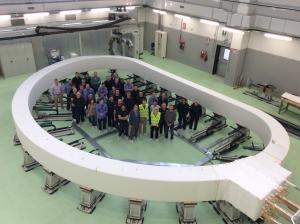First ITER winding pack completed in Europe
2 May 2016
-
European Domestic Agency, Fusion for Energy
A major ITER procurement milestone was recorded in April by the European Domestic Agency, as contractors completed the first 110-tonne toroidal field winding pack. The winding pack, or D-shaped inner core, will now be cold tested at -200 °C/80 K before being inserted into a massive stainless steel case to form a final toroidal field coil assembly measuring 9 x 17 metres and weighing 310 tonnes.
A giant magnet ... and a giant step forward for ITER. Representatives from the European Domestic Agency, the ITER Organization and contractors stand inside of the first inner winding pack of an ITER toroidal field coil.
Work is already underway on the assembly of a second winding pack at ASG Superconductors in La Spezia, Italy.
Europe estimates that more than 600 people from at least 26 companies have contributed to this milestone.
In ITER 18 toroidal field magnets—each made up of a winding pack and stainless steel coil case—will surround the vacuum vessel to produce the powerful magnetic field that will confine the particles of the ITER plasma. Europe has the procurement responsibility for half the coils plus one spare; Japan is producing nine coils and all stainless steel coil cases.
For Alessandro Bonito-Oliva, Europe's manager for magnets, "This is a landmark achievement for the whole project. We have been working really hard to meet the tight planning and manage all interfaces so that all pieces come together at the right time. The very good collaboration between the teams of the European Domestic Agency, the ITER Organization and the Japanese Domestic Agency has helped us to reach this point and go beyond as production accelerates."
To produce the first toroidal field winding pack, European contractors Iberdrola (Spain), ASG Superconductors (Italy), and Elytt Energy (Spain) collaborated closely with radial plate manufacturers CNIM and SIMIC. The step-by-step process included the winding of cable-in-conduit, niobium-tin-based superconductors into flat spirals called double pancakes, insertion into radial plates, impregnation with epoxy resin, and finally the stacking, jointing, wrapping, and full electrical insulation of seven double pancakes to form the final winding pack.
Europe estimates that more than 600 people from at least 26 companies have contributed to this milestone.


